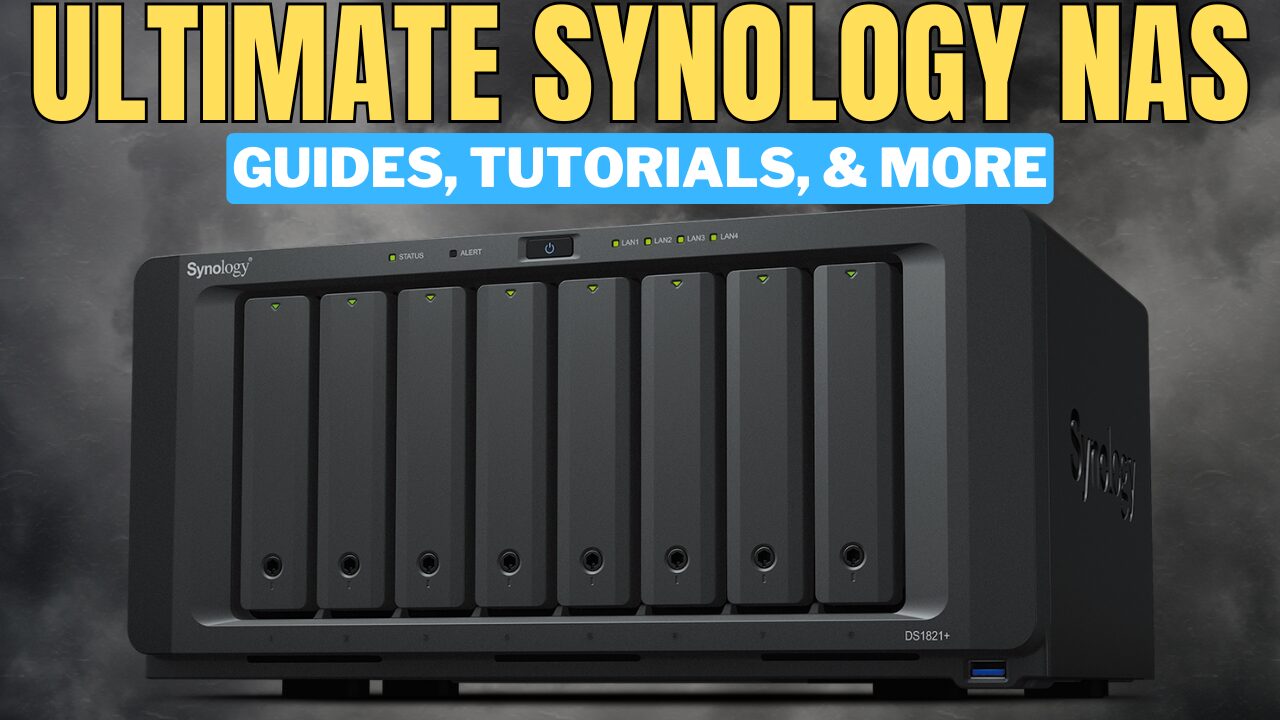Synology NAS: Expert Setup & Configuration Guides
If you own a Synology NAS, you know how great Synology devices are…mainly because of DiskStation Manager (DSM), which is the operating system. DSM offers extreme customization options, but requires an understanding of RAID, storage pools, volumes, and more.
Below, you’ll find various Synology NAS tutorials, troubleshooting guides, and best practices for configuring DSM and its associated applications. These articles have been created from the extensive experience I’ve amassed over eight years using Synology devices and DSM in enterprise environments, and as a consultant for many clients!

Why Should You Buy a Synology NAS?
One of the biggest questions you’ll have to answer is whether a Synology NAS is the right option for you. Synology devices are sold as an all-in-one solution, meaning the hardware comes with DSM (the NAS OS) preinstalled. There are many options that you can use in this category, and while I suggest a Synology device for almost everyone (if an AIO NAS is what you’re looking for), check out some of our guides if you’re interested in learning about the differences.
If you’re certain that you want a Synology NAS, check out our Synology NAS buying guide that will walk you through selecting the best option, or the best options for Plex if you’re looking to build a media server.
Featured Content on Synology NAS Devices and DSM
Check out our expert guides on Synology NAS devices and the DSM operating system. From setting up the device to advanced features and functionality – we have you covered!
Getting Started with Synology DSM
I’d suggest following the steps to ensure that when you configure DSM, you select the correct RAID type.
- Best RAID Type for Synology Devices
- Btrfs vs Ext4 (and why you should use Btrfs)
- How to Find a Synology Device on a Network
- Ultimate Setup Guide for Synology NAS Devices
- Correct Way of Shutting Down a Synology Device
- Adding RAM to a Synology NAS (if you purchased or need more)
Enhancing the Security of Synology DSM
- Best Practices for Securing Synology DSM
- Protecting DSM from Ransomware Attacks
- Configuring the Firewall
Enhancing the Configuration of Synology DSM
- How to Expand a Storage Pool
- Configuring SSD Cache on a Volume
- Configuring SMB Multichannel for Increased Network Performance
- Using a Reverse Proxy Server
- Configuring Link Aggregation (LACP)
- How to SSH into Synology DSM
- Replicating Snapshots to a Second Synology Device
- Configuring System Notifications
Using Applications on Synology DSM
- How to Set up Synology Drive
- How to Use Docker/Container Manager
- How to Install and Configure Plex
- Configuring Synology Surveillance Station
- How to Configure Jellyfin
- How to Configure Home Assistant
- How to Use Synology Cloud Sync
- Synology Photos Setup
- How to Set Up Pi-hole on a Synology NAS
- How to Configure Nginx Proxy Manager
Backups in Synology DSM
- Backing up macOS using Time Machine
- Configuring Hyper Backup
- Backing up Linux Devices with Active Backup for Business
- Backing up a Windows PC with Active Backup for Business
- Backing up a Synology NAS to a Remote Synology
- Backing up a Synology NAS to Backblaze B2
- How to back up a Synology NAS to Synology C2
Remote Access Setup & Best Practices
- Configuring OpenVPN on a Synology NAS for Remote Access
- Configuring Synology QuickConnect
- Tailscale Configuration for Remote Access
- How to Access Synology DSM with DDNS
- How to Configure Twingate on a Synology NAS
- How to Connect to NordVPN on a Synology
File Services in Synology DSM
Maintenance for DSM / NAS Hardware
- How to Configure Data Scrubbing
- Viewing System Logs
- How to Replace a Failing Hard Drive
- Testing Network Performance with iPerf3
- Configuring a UPS Device
- How to Configure Wake-on-LAN
- How to Use a Synology NAS as a NUT Server
Community Resources
Synology has a great user community, with various sites, forums, and pages dedicated to supporting Synology devices and DSM. Some of my favorites include r/Synology, the Unofficial Synology Forum, and the Synology User Community on Facebook!
Synology NAS FAQs
Can you install your own OS on a Synology Device?
Generally, Synology devices are designed to run with the included operating system, DiskStation Manager (DSM). If you want to install your own OS, it’s better to go with non-Synology hardware.
What does a Synology NAS Do?
A Synology NAS is a Network Attached Storage (NAS) device. This means that multiple hard drives work together to provide a centralized storage server on your network.
Should I Leave My Synology NAS on 24/7?
Synology devices are designed for 24/7 operation. While you can specify different power schedules, it’s generally best to keep them on 24/7 so you can access your data when you need it.
Does Synology Use Wi-Fi?
No, Synology devices come with dedicated NICs for wired Ethernet cables. This provides better performance and reliability than Wi-Fi does.
